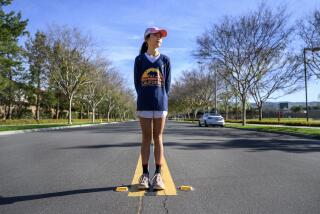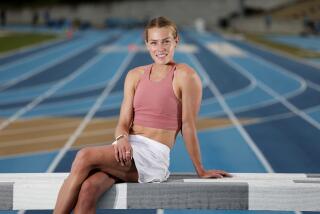‘Carbo-Loading’
- Share via
There’s a green light on the system of “carbohydrate loading” to prolong endurance during a marathon race . . . but a red light for those who misuse it.
In other words, carbohydrate loading can be a marathon runner’s
life spring or a trap, depending on what foods are eaten.
“One of the biggest problems of a runner is that burning excessive calories gives many runners license to load up on the wrong foods, such as foods containing high amounts of fat,” said registered dietitian Evelyn Tribole, a private consulting nutritionist. Tribole, herself a marathon runner, is also author of “Eating on the Run” (Life Enhancement Publications: $8.95), whose release will coincide with the second Los Angeles Marathon on Sunday.
Glycogen stores, which provide fuel to the muscles to work, are supplied by carbohydrate foods, such as fruits, vegetables and grains, not by fat or protein. “Several studies have shown that when glycogen stores have run out, exhaustion sets in,” Tribole said.
Athletes, she noted, eat too much fat. “They eat as much fat as most average Americans--about 42%. And that’s too much,” Tribole said. “It’s important to have a full amount of the stores of glycogen, and to do this you need 60% to 70% of calories in the diet derived from carbohydrates.”
But not just any old carbohydrates will do. Studies have shown that complex carbohydrates, such as grains, legumes, fruits and vegetables, fill glycogen stores better than simple carbohydrates, such as those found in sugars.
Some of the classic complex carbohydrate foods are breads, cereals, pasta, potatoes, yams, legumes (such as lentils and split peas), other vegetables and fruits. Pancakes, which are popular among runners, are an excellent source of complex carbohydrates.
How much should a runner eat of these foods?
Whereas the average individual should eat normal amounts of the four food groups (two servings each of meat and dairy products and four servings each of grains and fruits and/or vegetables per day), the recommended amount for the active runner is 12 servings from the bread and cereal group and eight servings from the fruit and/or vegetable group, due to the excessive amount of energy expended in marathon-type running.
A word of caution when eating a large amount of fruits. “Excessive fruit intake causes a diarrhetic reaction and may prevent a runner from finishing a race altogether,” Tribole said.
The positive value of the carbohydrate loading theory--the systematic method of first unloading and then reloading the body of glycogen stores before a race to prolong endurance--was given the green light only recently, when a study showed conclusively that the method (controversial up to now) actually does prolong endurance.
“The principle of ‘carbo-loading,’ as it is sometimes called, is to increase glycogen stores in order to run further, not faster, before hitting the proverbial wall,” Tribole said. The expression “hitting the wall” refers to the point when energy stores are drained--usually at about the 20-mile mark, depending on the individual’s training and physiological makeup.
The new carbohydrate loading format was based on a 1981 Ball State University study by William M. Sherman Ph.D., David L. Costill Ph.D. and William J. Fink Ph.D. The original form was introduced by a Swedish scientist in the late 1960s.
According to Tribole, this is how the basic format works:
Phase 1: Count down six days before the race.
Training Segment:
Day 6: Run 90 minutes.
Day 5: Run 40 minutes.
Day 4: Run 40 minutes.
Dietary Segment:
During days 6, 5 and 4 eat a normal diet of the four food groups (two servings meat; two servings dairy products; four servings or more fruits and/or vegetables; four servings or more breads or cereal.
Phase 2: Count down the next three days.
Training Segment:
Day 3: Run 20 minutes.
Day 2: Run 20 minutes.
Day 1 (day before the race): Complete rest. (Light jogging is considered fine for keeping limber.)
Dietary Segment:
During days 3, 2 and 1, eat a diet high in complex carbohydrates. The diet should consist of 12 servings or breads, grains or cereals, eight servings of vegetables and/or fruit and two servings or more of dairy products and two servings of meat. The total amount of carbohydrate should not exceed 625 grams a day.
“We have learned from research there is a topping-off effect on 625 grams a day of carbohydrates,” Tribole said. “If you eat more than 625 grams a day at this time, there will be no proportionate increase in glycogen stores. To explain this, I like to compare it with filling your gas tank beyond the fill-up limit. It’s just wasted.”
Tribole also warns against foods containing high amounts of fat, such as fried foods, ice cream, butter, sauces and fatty meats.
“If you are not running as much as you are eating, the body will simply store excess fats. And who wants to go around with excess fat when you’re running?” Tribole asked.
Tribole also had a few things to say about the latest on runners’ myths and fads, including ergogenic aids, which might enhance a runner’s performance. The term ergogenic aids refers to agents that help increase the body’s ability to work.
One of the most talked-about ergogenic aids currently is a substance known as glucose polymers, a powder added to water that is said to benefit running performance.
In the past, plain water was considered an ideal liquid to take during a run. “And water is the best liquid to use for short-term events lasting no more than two hours,” Tribole said.
Glucose Polymers
“However, new studies show that glucose polymers are providing extra carbohydrates during the marathon race and can be beneficial to an athlete,” she said.
Sporting goods or running stores carry the polymers in several brands, including Bodyfuel, Exceed and Max. The powder is simply stirred in fresh water to dissolve, and consumed as one might water.
A word about liquids, however. “It’s important to drink fluids during a run because thirst responses are blunted during a run and the athlete may become dehydrated without realizing it,” Tribole said.
It has been estimated that by the time one senses any thirst, there can be a 3% loss of body weight. “This has shown to hamper performance significantly in runners,” Tribole said.
Tribole cautioned against taking electrolytes ergogenically. “Electrolytes are not needed. Electrolytes are sodium, and Americans consume five to 10 times more sodium than they actually need.”
Caffeine, another controversial ergogenic aid, comes out smelling like a rose under the glare of scrutiny, according to Tribole. “There have been several good studies that show that caffeine might increase endurance. However, studies also show that side effects of too much caffeine may have a cathartic effect, thus hampering performance rather than benefiting it,” Tribole said. “Caffeine stimulates the mobilization of fat and, by doing so, (the body) can use fat as an energy sooner, thereby sparing glycogen. By delaying fatigue, one can improve endurance.” It’s recommended that caffeine be taken via coffee (2 1/2 cups or 250 milligrams).
Tribole also pointed out that caffeine, when measured in amounts equivalent to 20 cups of coffee, has been banned as a drug by the International Olympic Committee. Caffeine is also found in many over-the-counter products, including keep-awake aids.
Bee pollen, which has been touted as an ergogenic aid when taken in form of carnitine, has been deemed useless, and for some people, allergenic.
Carnitine, found in the mitochondria (the powerhouse of cells where energy reactions take place), is made naturally by the body. “We also get it from foods we eat, so there is no need to take it. However, some people are selling it as ‘the new and revolutionary B-T,’ a growth factor from meal worms discovered in 1947. There is nothing new or revolutionary about it,” Tribole said.
According to Tribole, intake of excess vitamins and minerals--often “a target by the fad food industry for repeat sales and profits”--do little for an athlete already consuming large amounts of vitamins and minerals by eating 5,000 to 6,000 calories per day. “Studies show that there are no excess vitamin and mineral requirements for runners,” Tribole said.
Another misconception is that taking large amounts of vitamins and minerals will provide extra energy. “Vitamins and minerals do not provide energy. Only calories, which come from carbohydrates, protein and fat, provide energy,” Tribole said.
Please see related story on marathon foods on Page 34.


